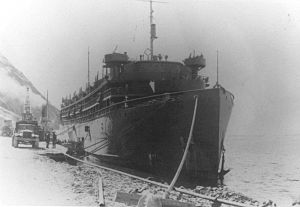SS Dorchester

SS Dorchester
|
|
| History | |
|---|---|
| Name: | SS Dorchester |
| Operator: | Merchants and Miners Transportation Company |
| Route: | Miami–Boston |
| Builder: | Newport News Shipbuilding and Dry Dock Company |
| Yard number: | 289 |
| Laid down: | September 10, 1925 |
| Launched: | March 20, 1926 |
| Acquired: | Delivered July 17, 1926. |
| Name: | SS Dorchester (troop transport) |
| Owner: | Control: War Shipping Administration |
| Operator: | Atlantic, Gulf & West Indies Steamship Lines (Agwilines) |
| Acquired: | January 24, 1942 |
| Fate: | Sunk by torpedo, February 3, 1943 |
| General characteristics | |
| Type: | Passenger ship / Troopship |
| Tonnage: | 5,649 gross register tons (GRT) |
| Length: | 368 ft (112 m) |
| Beam: | 52 ft (16 m) |
| Draft: | 19 ft (5.8 m) |
| Propulsion: | Reciprocating engines |
| Speed: | 12 knots (22 km/h; 14 mph) |
| Capacity: |
|
| Complement: |
|
| Armament: |
|
Dorchester was a War Shipping Administration troop ship operated by its agent Agwilines allocated to United States Army requirements that was sunk in the Labrador Sea by a torpedo from a German U-boat on February 3, 1943, during World War II. Of the 904 on board, 675 died (674 plus one of the 230 original survivors after being recovered). Dorchester had been sailing to Greenland as part of naval convoy SG 19 when the U-boat attacked.
The loss of the ship became especially famous because of the story of the death of four Army chaplains, known as the "Four Chaplains" or the "Immortal Chaplains," who all gave away their life jackets to save others before they died.
Dorchester, one of three identical ships, the first being Chatham (torpedoed and sunk August 27, 1943) and the last being Fairfax, was built for the Merchants and Miners Transportation Company by the Newport News Shipbuilding and Dry Dock Company. Keel laying was September 10, 1925 with launching on March 20, 1926 and delivery on July 17, 1926. The ship was designed for the coastwise trade with a capacity for 302 first class and 12 steerage passengers for a total of 314 with a crew of 90 along the East coast between Miami and Boston. Propulsion was by a 3,000 horsepower, triple expansion steam engine supplied by four oil fired Scotch boilers with steam at 220 pounds pressure driving a single propeller for a speed of 13.5 knots (15.5 mph; 25.0 km/h).
Passengers were provided three decks, two promenade decks and the boat deck, with four suites having private baths and thirty rooms with beds, ninety-eight with double berths and eight with single berths with most opening onto both the corridor and deck and all had "European style" telephones with receiver and transmitter in one handset. Public spaces included a dance pavilion and sun parlor in addition to the typical lounge and smoking rooms. Cargo of about 3,300 tons was all handled through side ports rather than deck hatches. Refrigerated spaces of 1,873 cubic feet (53.0 m3) for provisions, including ice cream storage, was provided to six compartments cooled by a 4-ton Brunswick compressor. A separate chilled pantry had 210 cubic feet (5.9 m3) of storage.
...
Wikipedia
